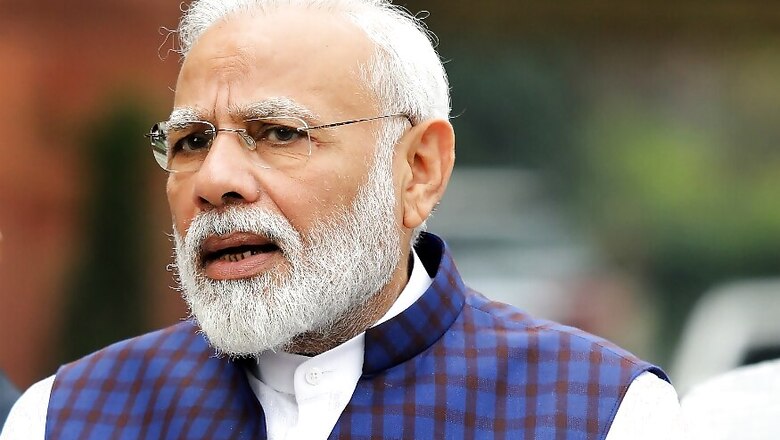
views
For Prime Minister Narendra Modi’s 12 May 2020 political slogan of Atmanirbhar Bharat to become a reality, he will have to wage a war. In this war, words and slogans will not do; at best they will be a starting point. This war will challenge an enemy that is deeply and integrally embedded in the political economy of India. It will have to obliterate the vested interests of a corrupt establishment. It will have to destroy carefully-created edifices of an unaccountable, entitled and rent-seeking economic system where the incumbent beneficiaries will fight back. It will have to be led by the Executive, at the Union and in states. It will need to be powered by tools crafted and repurposed in Legislatures, in the Parliament and Legislative Assemblies. This will be India’s war on regulatory excesses that have placed barriers to doing business and has slowed if not smothered entrepreneurship.
Between the ongoing trade wars on the one side and a potentially contracting global economy on the other, the path ahead was clear. But the tipping point of Atmanirbhar Bharat has been China on the border, the reaction to which has set the public discourse on fire. Business actors have announced their intentions. When the Chinese state propaganda outlet Global Times Editor-in-Chief Hu Xijin provoked India’s economic nationalism, Mahindra Group Chairman Anand Mahindra gave a fitting reply. On cue, JSW Cement Managing Director Parth Jindal said that the JSW Group has pledged to bring down $400 million of net imports from China to zero in the next 24 months. Three weeks earlier, the Confederation of All India Traders had launched its #BoycottChineseProducts campaign, with the objective to reduce Chinese imports by Rs 1 lakh crore by December 2021. Others are readying themselves to shun Chinese goods as a rising consumer movement seeks to upend India’s ‘cheap product’ addiction.
The government means business as well. On 29 June 2020, it banned 59 mobile apps that are “prejudicial to sovereignty and integrity of India,” defence of India, security of state and public order. Three days later, Minister for Road Transport and Highways, Minister of Shipping, and the Minister of Micro, Small and Medium Enterprises Nitin Gadkari said that no Chinese company will be allowed to bid for any highway project. This should now be extended to all critical infrastructure such as ports, energy, railways, broadband, banking and finance. Critical infrastructure comprises that whose destruction would adversely impact a country’s security, economy or safety. Taking the apps ban forward, the government must ensure no Chinese company, including but not restricted to Huawei, is allowed to offer 5G equipment to India’s telecom operators.
But this moment of ‘all of society’ cohesion on our economic future is only the first step. For a strategic and sustainable journey, India needs to be more hungry and ambitious. For which, the first thing Modi needs to do is to wage the war that all successive governments have been avoiding. This is a war on regulatory cholesterol that has been thickening and slowing the free flow of business, simultaneously weakening and feeding off the economic enthusiasm of entrepreneurs. The inertia is so overwhelming that most feel helpless and hopeless and even scoping what is needed appears futile. This essay hopes to change that narrative.
India’s web of compliances
Data from Avantis RegTech shows India’s regulatory universe to be a three-tiered complex. First, there is a mega-web of 1,536 laws that govern doing business in India, 678 (or 44%) enacted by Parliament, 858 (56%) by state Legislative Assemblies. From this web emerge mini-webs of 69,233 compliances, 25,537 (37%) at the Union level and 43,696 (63%) in the states. Finally, following the mega- and mini-webs is born a micro-web of 6,618 filings, 2,282 (34%) for the Union government and 4,336 (66%) for state governments.
This clear regulatory overreach happens across seven categories – labour; finance and taxation; environment, health and safety; secretarial; commercial; industry specific; and general. Further, these can be of 12 types – licences, registrations, permissions, consent orders, returns, displays, registers, challans, payments, remittances, renewals and notices.
And as if these laws, compliances and filings across categories and types were not enough, they change at the rate of 3,000 a year. In the last quarter alone, there were 1,206 changes, or about 13 a day. These changes are around seven areas – dates, frequencies, penalties, new compliances, reduction of compliance items, revisions to forms, and changes in rates.
To put these numbers in perspective, a small company with a single plant and up to 500 employees faces 23 licences or registrations, more than 60 laws, more than 750 compliances and needs to make more than 120 filings a year or one every three days. The numbers for a medium sized company with six plants and up to 5,000 employees are respectively 98, 135, 5,500 and 530 (or about three filings every two days). And for a large company of 11 plants and up to 10,000 employees, the numbers are 163, 210, 9,500 and 940 (or about five filings every two days).
India’s borders can be protected if Prime Minister Modi can defeat these excesses that have allowed perverse economic dependencies to emerge. He could make a start by getting Chief Ministers of NDA-governed states to join forces with him. While Madhya Pradesh is a prime example, Uttar Pradesh and Haryana could follow. This war will have to use three tactics.
Rationalisation
First, Modi will need to rationalise these 1,536 laws, 69,233 compliances and 6,618 filings and intimations. This review should identify redundancy and duplication of compliance. For instance, there are different definitions of wages under different labour Acts.
He will have to then reduce the other hurdles such as number of licenses or registrations, renewals, returns, and registers. The goods and services tax (GST) is a good model to follow. The GST has subsumed eight Union taxes and nine state taxes into a single indirect taxes structure. As a result, the number of registrations, payments, returns and filings have reduced dramatically.
Consolidation of laws is another option. Labour reforms, for instance, under which the government has decided to amalgamate 44 labour laws into four codes — code on wages, code on industrial relations, code on social security and safety, and code on health and working conditions. Code on wages has already been approved by Parliament and is awaiting notification. Introduction of labour codes is expected to reduce the number of registers and returns significantly.
Simplification
Second, he must simplify procedures. Not only is India’s regulatory environment vast, it is equally fluid. It changes more than 3,000 times a year. There are changes to due dates, duty structure, interest and penalty calculations, forms, applicability, threshold values, classifications among others. These changes are published on 2,233 websites across Union, state and local government levels, sometimes in local languages only. India needs a consolidated, central digital repository of all regulatory updates easily searchable by date, ministry, department, Union, state, union territory, or any other jurisdiction.
Further, the government should institutionalise a mandatory review of ease of doing business on any regulatory change on enterprises. Every change should pass through a litmus test on whether it improves or reduces the ease of doing business for employers. The framework should have parameters such as increase or decrease in complexity, paper work, cost of external consultants, and amount of time spent on compliances. Going forward, every change needs to help bring down the time and cost of compliance.
Digitisation
India needs to digitise at the speed of Aarogya Setu app. With Aarogra Setu, India has demonstrated its capability to conceptualise, build, deploy and distribute technology platforms to solve real world problems at an unprecedented pace. Corporate India is ready to embrace digitisation in managing its regulatory and compliance obligations.
The government should create an enterprise digital vault along the lines of Digi Locker. This vault should serve as a repository of all government issued documents such as licences, registrations, permissions, consent orders, certificates, and notices. Any other government department that needs to verify original documents should refer to this vault. This single initiative would save millions of sheets of paper a year and thousands of hours of lost productivity in printing, self-attesting, notarising and archiving paper.
In addition, the government needs to work towards converting every department that acts as a regulatory body to go cashless, paperless and faceless. They have to go beyond just creating a website and uploading records. They need to create an open digital ecosystem, which offers a secure open architecture for the vendor platform to connect with them and enable filings along the lines of income tax and GST. This will enable automated record reconciliation, identify leakages, detect frauds and flag discrepancies.
Strength on the border needs strength within the border
A robust border needs a buoyant economy. Such an economy needs to unleash the animal spirits of entrepreneurs and risk-takes such that they can convert ideas into jobs and wealth. And to unleash these animal spirits, India needs to reduce its regulatory cholesterol. China is not going away. Globalisation may take a break for a few years. Economic nationalism is becoming the new currency of short-term discourse. Fixing India from within will protect India from outside – physically and economically. If Atmanirbhar Bharat is the political aspiration, this war on regulatory cholesterol is an economic prerequisite.
This article first appeared in ORF.













Comments
0 comment